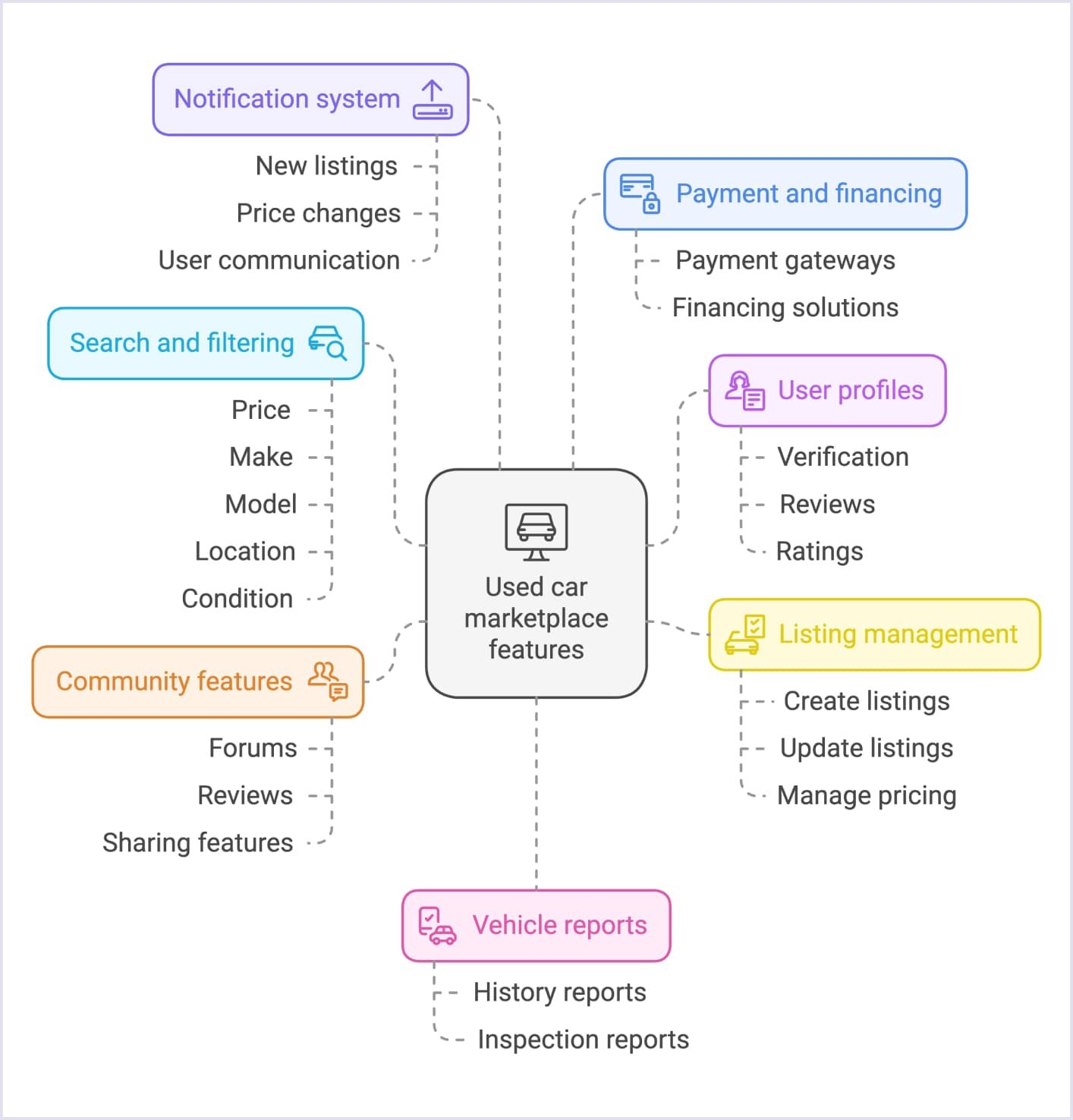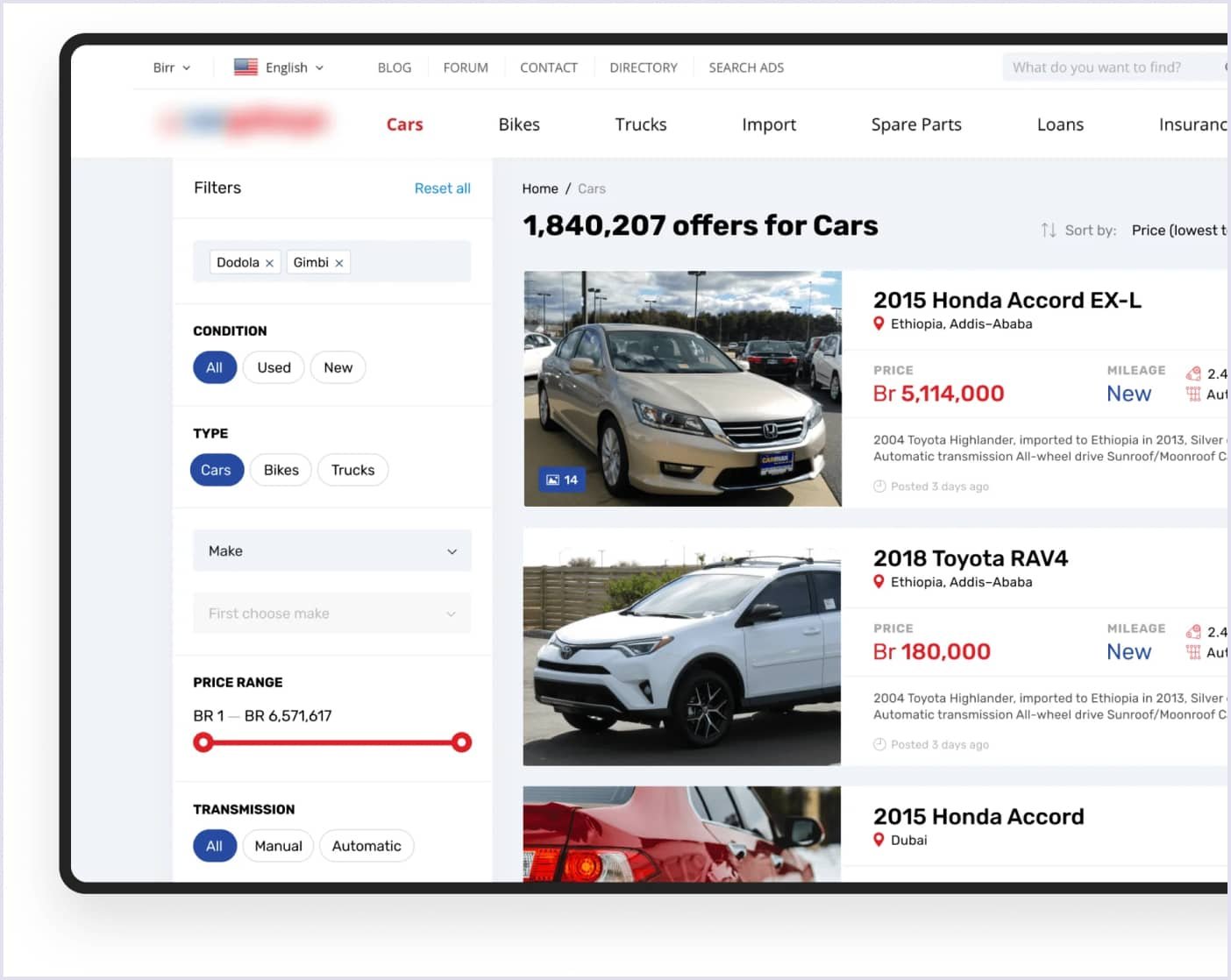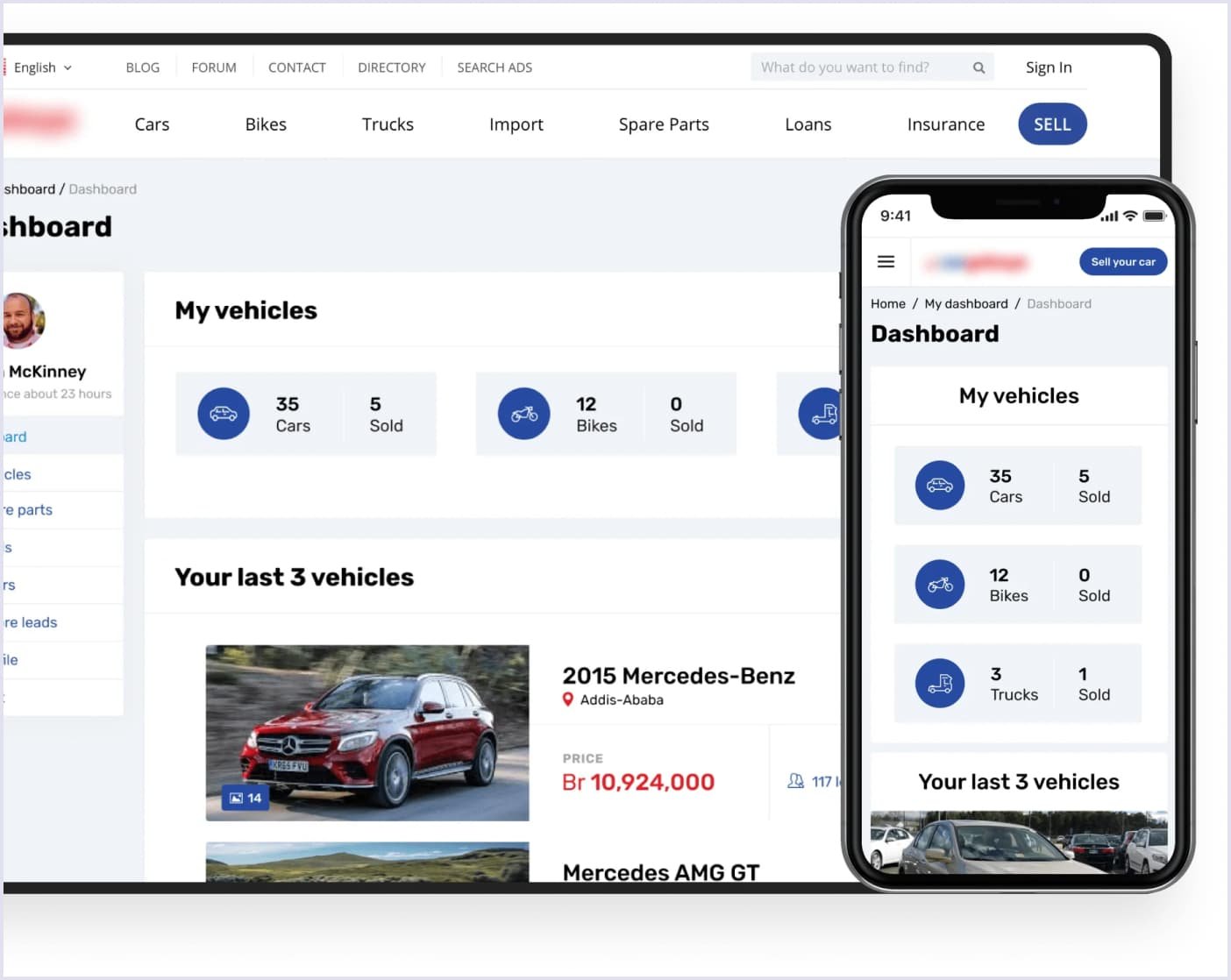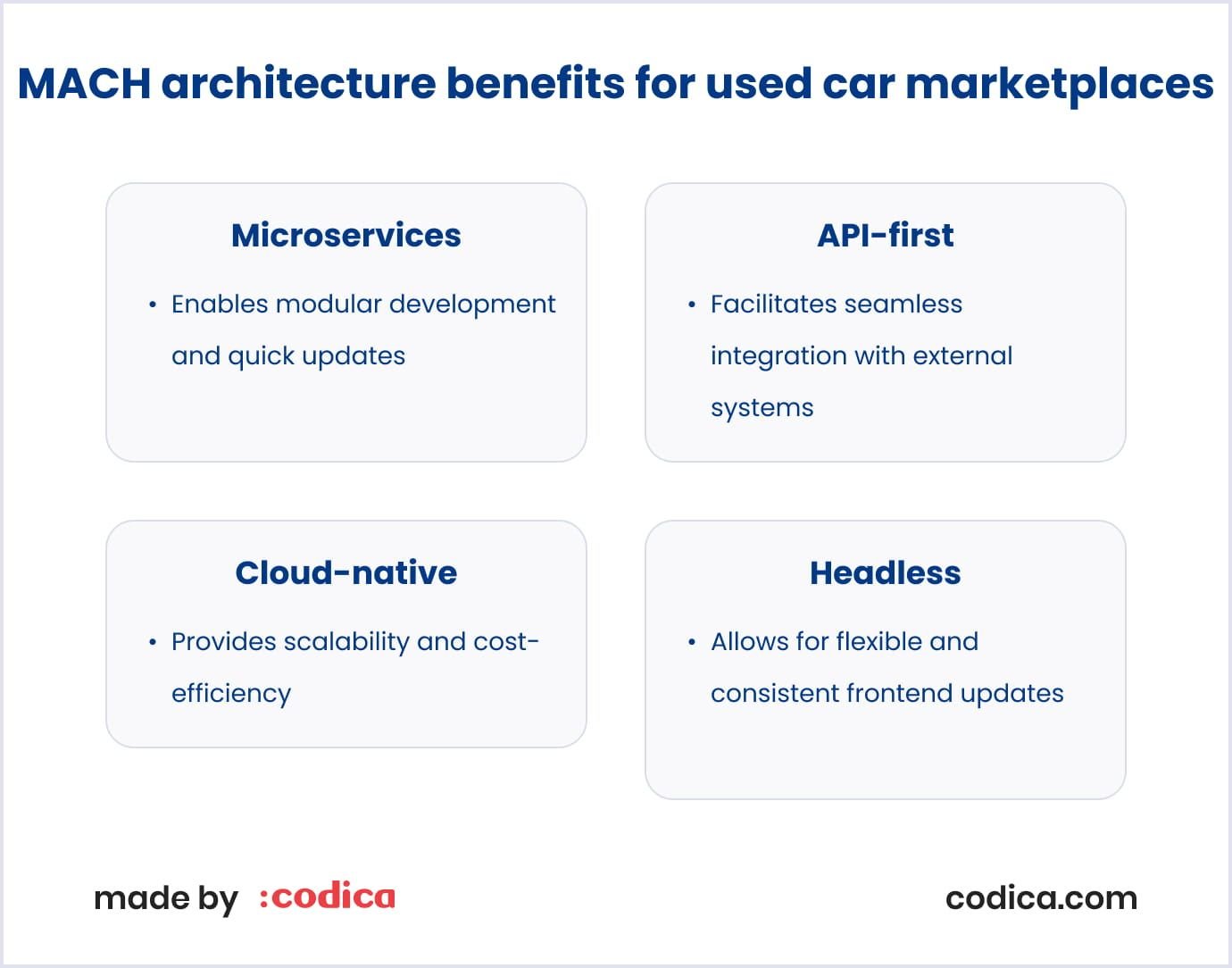Marketplace development is always portrayed as something extremely difficult and over-the-top expensive. In fact, it doesn’t have to be. The right approach and a reliable software development partner can do the majority of the task.
In this article, let’s overview everything you need to create such a marketplace. That being said, we’ll go through key features your marketplace needs, a short guide on how to build it, and tips you’ll find useful along the way.
Key features of a successful used car marketplace
A successful marketplace is one that really knows consumer expectations and demands. Both buyers and sellers want a scalable online car platform that is reliable, simple to use, and furnished with tools meant to streamline the car purchasing and selling processes. Thus, here are the must-have features.

Advanced search and filtering options
An intuitive search and filtering system is the backbone of good service. When shopping for a car, buyers often have specific criteria in mind. In turn, advanced search options provides a possibility to narrow down their choices based on various factors, such as:
- Make and model. Let users search brands they like, along with all models, to match their preferences.
- Year and mileage. Filters for production year and odometer readings help users assess the vehicle’s age and usage.
- Price range. Setting minimum and maximum prices ensures buyers can focus on cars within their budget.
- Condition and location. Advanced search filters for cars, their condition (new, used, certified, pre-owned), and proximity to the buyer’s location enhance convenience.

Seller and buyer profiles
Detailed profiles for both buyers and sellers are essential for building trust between two parties. Therefore, thoughtful user profiles on your marketplace should include:

- Verification badges. Indicating whether the user has been authenticated, improving credibility.
- Contact information. Allowing secure and monitored messaging between parties.
- Reviews and ratings. Enabling users to rate and review their experiences, helping others assess the reliability of a buyer or seller.
- Transaction history. Displaying past transactions to demonstrate the user’s activity and reliability on the platform.
Vehicle listing management
Effective listing management tools provide sellers functionality to make listing their vehicles both quick and efficient, increasing their appeal to buyers. To simplify listing management, think about implementing:
- Easy upload process. Simplifying the addition of vehicle details such as make, model, year, mileage, and condition.
- Photo uploads. Sellers should be able to post high-quality photographs because visuals greatly influence a buyer's interest.
- Pricing tools. Providing sellers with calculators or advice based on market pricing to help them set competitive prices.
- Editing and updating. Giving vendors the freedom to update their listings whenever they want to fix mistakes or reflect changes in price or availability.
Secure payment and financing options
Transactions in a used automobile market involve large sums of money. Making secure payment integration first then becomes a major concern. Additionally, offering financing solutions can expand the buyer base by making vehicles more affordable. Therefore, you can incorporate:
- Integrated payment gateways. These provide secure options for transactions. You can use bank transfers, Apple and Google Pay, or credit/debit card payments to protect both parties.
- Financing calculators. Based on vehicle pricing, down payment, and interest rates, they can assist consumers in investigating loan possibilities and project monthly payments.
- Payment tracking. This feature lets sellers and buyers keep an eye on the state of the transaction in case it gets processed and takes more time.
- Refund and dispute policies. They help address potential issues with clear and fair policies for refunds or disputes.
Community and social features
In specialized marketplaces, a natural community and the ability to engage with it is a strong trust-building instrument. Hence, creating a community around car ownership and buying is a super-needed feature. You can organize it differently, though:
- Forums and Q&A. Let users ask questions and share advice about cars, maintenance, or marketplace tips.
- Events and meetups. Promote local car-related events or meetups for enthusiasts and buyers.
- Social sharing options. Allow users to share listings on social media to increase visibility for sellers.

Smart notification system
A robust notification system is a must-have feature for this type of marketplace. It can keep users informed and make sure they don’t miss what they’re looking for. It can be implemented across various touchpoints.
- Real-time updates. Notify users instantly about key activities or changes on the platform. For example, they should receive new messages or inquiries from buyers or sellers, status updates on transactions or payment processing, and vehicle availability changes.
- Personalized alerts. You can let users customize the notifications they receive to optimize UX. Hence, allow them to receive alerts about price drops, new listings matching criteria they specified, seller updates, and more.
- Reminders and recommendations. When set up in a timely manner, recommendations and reminders can boost your marketplace metrics. Examples are endless: you can remind sellers to update or renew listings that are about to expire and suggest similar vehicles to buyers if their preferred choice is sold. prompt users to complete profiles or upload missing details for better visibility, and so much more.
- Cross-platform support. To maximize efficiency and provide comfort for users, ensure notifications reach users in different ways. For instance, you can set up push notifications for mobile app users, email notifications For detailed updates or summaries, and SMS messages for urgent updates.
Vehicle history reports and inspection integration
In used car marketplaces, there’s a level of uncertainty buyers might feel before making a purchase. They want assurance about the vehicle’s condition and history before investing. Therefore, you can simplify and increase buyer confidence by integrating tools or services that provide vehicle history and inspection details.
- Vehicle history reports. Automatically fetch reports (e.g., from Carfax or AutoCheck) to provide information about accidents, ownership changes, and maintenance records.
- Inspection services. Partner with local mechanics or inspection agencies to offer pre-purchase inspection services directly through the platform.
- Damage and recall alerts. Highlight any manufacturer recalls or significant past damages to ensure transparency.
As you can see, many examples were from a single case. It was a multi-vendor vehicle marketplace we built at Codica. Naturally, it is a similar car-centered marketplace you’re researching. It went through the same development process we will list next and ended up being a successful startup working to this day.
Here’s an overview of how it works, looks, and feels.
A step-by-step guide to building a used car marketplace
Step 1: Defining business objectives and target audience
Get your business objectives and target audience defined before you start developing. Here at Codica, we bundle all of the pre-marketplace development research under our product discovery services.
Notably, one of the most important things we do is identify business goals. Are you aiming to connect private sellers with buyers, serve as a dealership-focused platform, or cater to both?
We help you decide whether your focus will be local, national, or global and whether you’ll monetize through listing fees, subscriptions, or advertising.
Through market research, another process we conduct, we can identify the needs and pain points of various user categories in your marketplace. For instance:
- Private sellers. They want an easy way to list vehicles and reach potential buyers.
- Dealerships. They need bulk upload capabilities, inventory management, and lead tracking.
- Buyers. They look for a transparent and seamless way to search, compare, and purchase vehicles. Hence, consider features like detailed filters, price comparisons, and vehicle history reports.
Collecting and processing all gathered information proves extremely useful throughout the entire development process. Here are all the deliverables you will get as the product discovery concludes:
Read also: What is Project Discovery Phase in Custom Software Development
Step 2: Choosing the right development approach
Another part of our services is the choice of development approach. It depends on many variables, like budget, timeline, and technical requirements.
In all cases, we lean toward custom development, as it is our way of developing complex products. It is ideal for unique features and full control over the platform. Notably, there are plenty of tools we can leverage to achieve the desired result. For instance, our tech stack for building a used car marketplace includes:
- Frontend. JavaScript, TypeScript, React, Redux, Next.js, Vue.js, Gatsby.
- Backend. Ruby, Ruby on Rails, Strapi, Node.js, Nest.js.
- DevOps. Linux, Ansible, Docker, Gitlab CI, Terraform, Packer, Vagrant.
- Databases. PostgreSQL, MySQL, Mongo DB, Redis, Firebase, Elasticsearch.
- Infrastructure. AWS, Digital Ocean, Heroku, Linode.

Step 3: Designing the user interface and user experience
A user-friendly design is critical to the success of your platform. The customer journey should be seamless, intuitive, and readable at a glance. This, our UI/UX design services achieve in numerous ways.
- Responsive design. As a rule of thumb, we design marketplaces to work seamlessly regardless of the device. Thus, users can expect the same level of performance on desktops, tablets, and smartphones. After all, buyers and sellers should have consistent experiences as they directly affect success metrics.
- Intuitive navigation. To reinforce user-friendly design, we organize categories, filters, and menus logically. Simply speaking, elements similar in functionality are grouped together, and the search system always stands out, while secondary features are somewhat hidden so as not to distract users.
- Separate dashboards. Marketplaces should be comfortable for both parties, i.e., sellers and buyers. Thus, we implement tailored dashboards for them. Each party has dedicated tools needed for work.
- Visual appeal. The design should be consistent throughout the marketplace. This is done using clean layouts, high-quality images, and branding to simplify usage sessions.
Step 4: Employing minimum viable product development
Your marketplace’s features determine its usability and appeal. Therefore, you need to prioritize previously outlined key functionalities that people will need most.
The development process itself should be a point of interest for you as well. At Codica, we offer a great solution in the form of MVP. Before the final product gets created, we develop a minimalistic version of it. Basically, it includes only primary functionality and gets released to a limited range of users.
What’s in it for you? A lot, actually. Think about it: with a simplified version of your future marketplace, you spend significantly less time and funds on its development. Basically, you get a version you can quickly iterate on, test its idea UI/UX, and suggest changes we can make. Here’s a quick overview of all the benefits MVP development services provide.
In the marketplace development scope, it’s a wise solution for founders who don’t just create products for the sake of it. Instead, it’s a choice for people who seek to create products efficiently, optimizing expenses and development time.
Step 5: Testing, launching, and marketing
The final step is quality assurance services, which are carried out after the primary development component is finished. In order to find issues and defects with your marketplace before it is published to the public, QA specialists use a wide variety of approaches and methodologies.
For instance, they conduct functional, usability, and performance testing to identify and fix issues. Following responsible design principles, they also test responsiveness across various devices and browsers.
When it comes to online marketplace marketing, there’s a plethora of considerations. First and foremost, you need to create a strategy that will encompass all your SEO, SMM, and advertising efforts.
Read also: How Automation Testing Increases Execution Speed, Test Coverage, and Effectiveness
Leveraging MACH architecture for scalability and flexibility
Using microservices, APIs first, cloud-native, and a headless architecture is known as MACH. It is a versatile platform for creating strong and scalable solutions.
You can utilize MACH architecture as a starting point for your used automobile marketplace. We can examine each component to see how they can benefit your business.

Microservices for modular development
Microservices for ecommerce platforms can break down the marketplace’s functionalities into independent, modular services. This modular approach simplifies development and supports independent scaling so that no single component becomes a bottleneck during high-traffic periods. For instance:
- Search. A dedicated microservice can handle search functionality optimized for performance with indexing and caching tailored to the large volume of vehicle data.
- Payments. With microservices, you can add functionality to process payments independently. This way, even during peak activity, you can ensure secure and smooth transactions.
API-first for seamless integration
Thanks to the API-first strategy, the marketplace is created with strong and well-documented APIs. The value of the platform is increased for users when third-party services can be seamlessly integrated using APIs. Important application programming interfaces (APIs) for used automobile marketplaces include:
- Payment gateways. You can simplify transactions by connecting to trusted payment processors.
- Financing options. Enable users to access car loans or installment plans through integrated financial services.
- Vehicle history databases. They provide detailed insights into a vehicle’s past, such as accident reports and maintenance records, fostering trust and informed decision-making.
Cloud-native for scalability
Cloud-native infrastructure for cars marketplace is essential for handling the dynamic and unpredictable nature of user demands. With moving a lot of operations on cloud platforms, your marketplace benefits from:
- Dynamic scaling. To control traffic spikes during peak activities or promotional campaigns, you can automatically scale resources up or down.
- High availability. This ensures uptime through distributed cloud environments, minimizing the risk of service disruptions.
- Cost efficiency. Pay for resources on demand, optimizing costs without compromising performance.
Headless architecture for customization
Headless architecture lets the frontend and backend separate, therefore allowing unmatched user interface design flexibility. This strategy enables the market to provide a consistent and customized experience over several devices and channels, therefore empowering them. Key benefits include:
- Tailored frontends. They allow you to customize the user interface for web, mobile, and even voice-activated platforms, ensuring accessibility and ease of use.
- Agility in design. With agility, you can quickly adapt to changing user preferences or introduce new features without affecting backend stability.
- Future-proofing. You can seamlessly integrate emerging technologies and devices, staying ahead of industry trends.

Cost to build a used car marketplace MVP
As previously mentioned, used car marketplace development lists dozens of features and processes. Therefore, MVP development would be a great start to prove your idea is worth the investment. Additionally, MVP is much more cost-efficient compared to the full-scale product.
Here’s a breakdown of the approximate pricing for marketplace MVP development. Note that we center it around $50 per hour, as it’s a common price for software development in Eastern Europe.
| Features | Time, hours | Cost ($50/h) |
| Design | ||
| UX development | 56 | $2,800 |
| UI development | 64 | $3,200 |
| Architecture | ||
| Project setup | 16 | $800 |
| DB structure | 32 | $1,600 |
| Integrations | ||
| Payment (Stripe or PayPal) | 64 | $3,200 |
| Main functionality | ||
| Authorization and security | 32 | $1,600 |
| User profiles | 42 | $2,100 |
| Homepage | 24 | $1,200 |
| Advanced search and filters | 96 | $4,800 |
| Vehicle listing management | 64 | $3,200 |
| Reviews and ratings | 64 | $3,200 |
| Notifications | 32 | $1,600 |
| Finance managment | 64 | $3,200 |
| Buyer panel | 84 | $4,200 |
| Seller panel | 84 | $4,200 |
| Admin panel | 96 | $4,800 |
| Non-development activity | ||
| Project management | 64 | $3,200 |
| Quality assurance | 80 | $4,000 |
| Code review | 48 | $2,400 |
| Total | 1106 | $55,300 |
Monetization strategies for a used car marketplace
For markets to be successful and sustainable over time, they need monetization tactics that work. There are a number of approaches you can take when dealing with the used automobile market in particular.
Listing fees and subscription plans
This one is the most straightforward monetization strategy. It implies charging sellers for listing their vehicles on the platform, as simple as that. You can implement it differently, though.
- Pay-per-listing model. Sellers pay a fixed fee for each vehicle they list. This works well for individual sellers or those with infrequent listings.
- Subscription plans. Offer tiered subscription plans for private sellers and dealerships, providing benefits like unlimited listings, advanced analytics, or enhanced visibility for their vehicles. For instance, a basic plan might include standard listings, while premium plans could feature highlighted listings, priority support, or marketing tools.
Transaction fees
Earning a commission on successful transactions is another common approach used in marketplaces. Under this model, the marketplace charges a percentage or flat fee based on the final sale price of the vehicle.
- Percentage-based commission. This aligns the marketplace’s revenue with the value of the transaction, making it scalable as higher-value vehicles are sold.
- Flat fee per sale. Offers predictability and simplicity, appealing to both buyers and sellers who prefer straightforward pricing.
However, note that these fees should be communicated upfront, along with any value-added services provided (i.e., escrow, payment processing, buyer protection). This way, you will preserve trust and transparency.
Advertising and partnerships
Advertising and strategic partnerships can provide significant revenue without directly charging users for core services. This comes as an alternative monetization model, and you can either rely solely on it or use it to complement other strategies. Anyways, with advertising and partnerships, you can come up with:
- Sponsored listings. Sellers can pay to promote their listings, ensuring greater visibility on the platform. Sponsored listings can appear at the top of search results or in premium slots on the homepage.
- Display advertising. Allow brands to advertise within the platform, targeting users with relevant ads, such as car loans, insurance, or accessories.
- Partnerships with automotive service providers. Collaborate with companies offering services like insurance, financing, maintenance, and roadside assistance. The marketplace can earn referral commissions or establish revenue-sharing agreements.
Overcoming common challenges in building a used car marketplace
Building a successful and scalable automotive marketplace always poses a variety of challenges. They are different in nature, yet there are many ways to overcome each of them.
Ensuring data accuracy and listings verification
One of the biggest challenges in a used car marketplace is the accuracy of postings. They must always have enough vehicle details. Misinformation or fraudulent activity can damage your platform’s reputation and erode user trust.
You can use a rigorous verification process to help prevent this situation from ever materializing. Confirm the vehicle information and dealer ID that you have provided. Therefore, records such as proof of ownership, registration, and service records are required before approving listings.
Next, create photo and content guidelines. Establish clear guidelines for listing photos and descriptions. Then, you can use various AI tools to detect altered images or inappropriate content.
Alternatively, you can collaborate with third-party services for vehicle history checks, such as accident records, mileage verification, and maintenance history.
Managing diverse user needs
Each with different needs, a used automobile market serves private sellers, dealerships, and consumers. A smooth experience for every user depends on carefully balancing these needs. You may control this variety of user needs by performing many actions.
You can create customized features to start. Create customer, dealership, and private seller specialized interfaces. Private sellers could need fast upload tools, for instance, but dealerships could gain from mass listing possibilities.
Besides, a clever search system ought to be in place as well. You can significantly meet different needs by including sophisticated filters to assist consumers in locating vehicles depending on particular criteria such as price, location, mileage, or model year.
Addressing scalability issues
Particularly successful markets expand, and occasionally, this process happens far faster than you would have predicted. Consequently, the scalability of your marketplace can provide a major obstacle. If poorly controlled, high traffic levels and growing user expectations can tax your infrastructure. Typically, there are multiple answers.
One might take advantage of cloud-based hosting options. Their assistance will let you shift some operations to the cloud, therefore facilitating platform scalability and freeing up server resources during high demand.
Load balancing methods can also be really beneficial. They guarantee constant performance by letting you equally distribute traffic among servers.
Last but not least, consider modular marketplace development. As seen in MACH architecture mentioned earlier, you can design your marketplace using a modular architecture, allowing you to add or upgrade features without disrupting the entire system.
Conclusion
In the aftermath, building a used car marketplace hardly differs from any other marketplace. Although it may have some differences, it is still based on key functionalities. For this reason, our online marketplace development services would be a perfect match for you if you’re looking to create your very own platform.
Therefore, feel free to contact us. It takes minutes, yet your initiative can lay a foundation for a successful marketplace. In case you’re not sure yet, check out our case studies, as the majority of our cases are marketplaces that can give you just enough inspiration to start your own.
